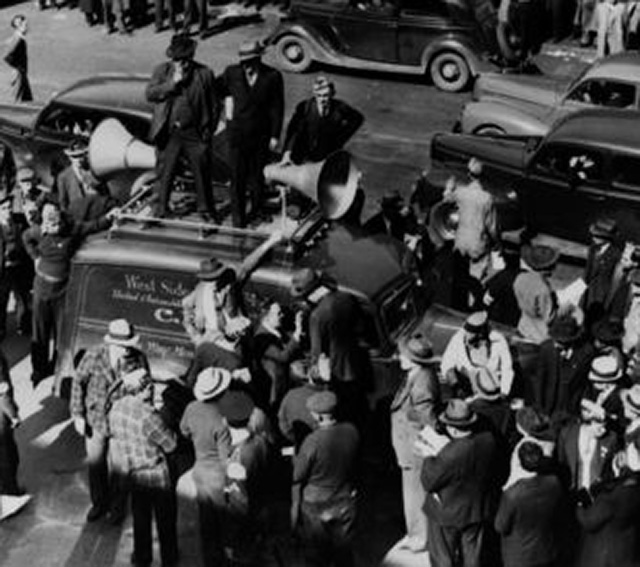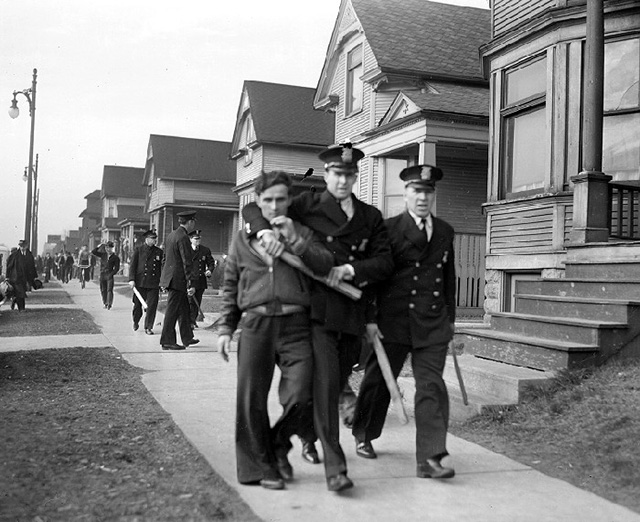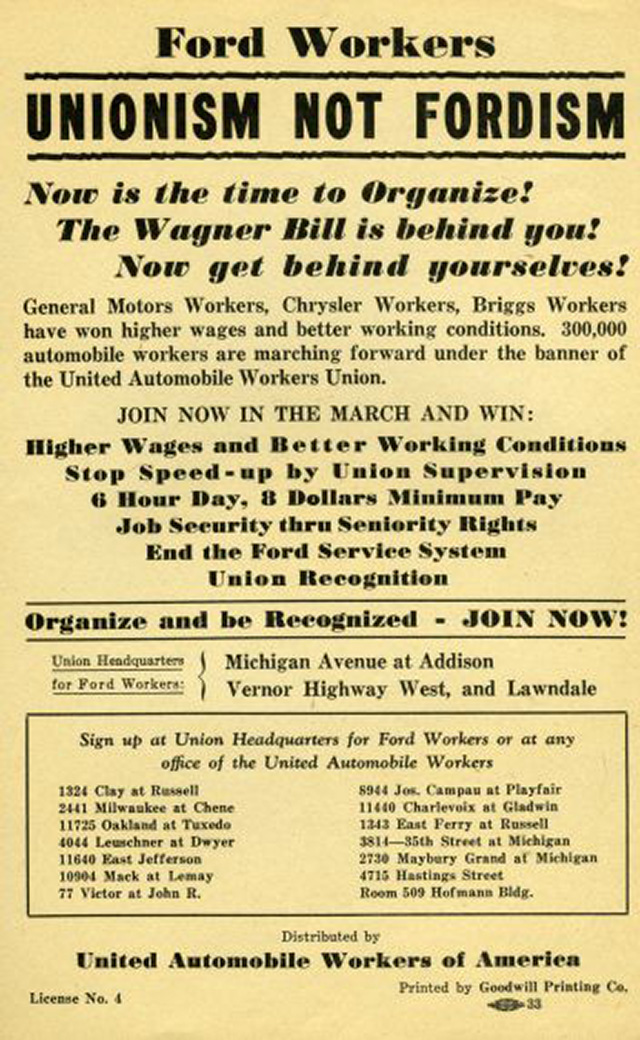 UAW Local 174's Federal Art Project - Work Progress Administration mural created by Walter Speck (1937)
UAW Local 174's Federal Art Project - Work Progress Administration mural created by Walter Speck (1937)
The tremendous successes of Detroit unionists in 1937 were threatened as 1938 approached. The United Auto Workers (UAW) had taken the industry by storm with successful sit-down strikes, beginning in late 1936 at Kelsey-Hayes, a major parts supplier to Ford. The UAW’s victory over General Motors (GM) in the Flint Sit-Down strike, which ended in February 1937, led to the successful organizing of the company’s Cadillac and Fleetwood plants in Southwest Detroit. Chrysler signed contracts with the union that spring, and the UAW also organized independent automakers such as Hudson and parts suppliers such as Briggs. UAW Local 174 represented many auto plants on Detroit’s west side, including some in Southwest Detroit, and its membership skyrocketed from 78 in November 1936 to 35,000 by March 1937. By mid-1937, many Detroiters thought that the Depression was over and, except at Ford, the UAW had established itself in the industry. But there was a serious economic downturn in late 1937, and it had a devastating impact on the auto industry and the UAW.
It was almost like the early 1930s all over again. During the winter of 1938, two hundred thousand UAW members were unemployed. Production in many auto factories fell as much as 50 percent. Company officials at eighteen of the twenty plants with which UAW Local 174 had contracts demanded wage cuts. UAW president Homer Martin seemed to accept wage reductions as inevitable. He publicly proclaimed that the UAW would not insist on higher rates than those paid by competing, small-town companies, a position that created tensions within the union’s executive leadership. In addition, in 1938 the Congress of Industrial Organizations (CIO), which pushed for industrial unionism -- the organization of all workers in an industry into the same union -- formally separated from the craft-union-based American Federation of Labor (AFL), a development that appeared to weaken the labor movement. The UAW had been one of the original CIO unions, but with the official split between the CIO and the AFL, some autoworkers and union leaders hoped to return to the AFL. In Detroit, this lack of unity in the ranks of organized labor had been apparent in the 1937 municipal elections, which saw anti-union forces capture both the mayor's office and the entire city council. The CIO fielded a slate of candidates, all of whom were defeated.
 West Side Local 174 Sound Car (1941)
West Side Local 174 Sound Car (1941)
“Things have changed in the City of Detroit,” one company manager boasted. “Labor is going to be put in its place, and any strikes, sit-downs or otherwise will no longer be tolerated.” That prediction was tested in a major showdown at Federal Screw Works (FSW), a Marin Street parts supplier that had been organized in 1937. In the midst of the 1938 downturn, the company demanded pay cuts of 10 to 20 percent for its remaining workers. In mid-1937, FSW had employed 350 people, but layoffs had reduced the workforce to 150, many of them Polish, and about 40% of them women. FSW management hoped that these immigrant women would be grateful to have jobs and could be pressured into compliance. The company’s higher-paid employees, all men and mostly German and Irish, who weren’t sympathetic to the union would recruit strikebreakers if necessary. FSW officials also threatened a lockout, refusing to let employees come to work, if that’s what it would take to implement the wage cuts.
The pro-union workers at FSW, however, fought back. They asked for help from Local 174, whose president, Walter Reuther, saw the conflict as “a test case for the entire wage structure of the auto industry.” Understanding just how much was at stake, not only for FSW workers but for organized labor more broadly, Reuther declared that “if the employers succeed here, they will chop wages everywhere else. For this reason, not only West Side local but union men and women everywhere are fighting it.” Reuther offered the assistance of Local 174, and labor organizer Stanley Nowak was crucial in communicating with the largely Polish workforce.

Members of Local 174 visited the homes of workers and others in the community to build support for their cause. When FSW workers rejected the company’s final offer, their solidarity was put to the test. At 7 a.m. on Monday, March 28, hundreds of strikers and sympathizers established picket lines in front of the plant. The police were also there in force, thanks to anti-union Mayor Richard Reading, and they formed a wedge to escort some 30 strikebreakers into the facility. The police and strikebreakers ran an angry gauntlet of both strikers and incensed neighborhood residents. The same thing happened at the 4 p.m. shift change and again the next morning, when police officers clubbed an elderly woman and drew guns on children who tried to protect her.
The crowd grew dramatically the following day, with as many 5,000 strikers and sympathizers parading behind a large American flag. More militant strike supporters stockpiled rocks and bottles, while the police, now numbering 600, armed themselves with tear gas. UAW members from Flint and Pontiac drove to Detroit in “flying squadrons” to assist the cause. In addition, Detroit members of the Teamsters union, still in the AFL and led by the up-and-coming Jimmy Hoffa, helped sustain this UAW-CIO effort.
As strikebreakers left the plant, the air filled quickly with jeers, taunts, and flying debris aimed squarely at them and their police escorts. The police broke ranks as they spread into the neighborhood, committing acts of violence as they went house to house. Several women dumped boiling water on officers from upstairs porches. On the streets, police clubbed a number of strike supporters into unconsciousness, including Percy Key, an African-American UAW activist and Cadillac foundry worker. In all, 40 picketers, 25 of the 30 or so strikebreakers, and 13 policemen had to be hospitalized. Union first aid workers treated many others. FSW managers closed their plant and at the next city council meeting, union supporters protested the use of police in the conflict.
The National Labor Relations Board, a federal agency created in 1935 to oversee and enforce workers’ right to collective bargaining, helped restart bargaining at FSW, and on April 9, strikers approved a new contract that recognized the UAW as their sole bargaining agent and maintained their wages without any cuts. The contract also included improvements to seniority provisions and overtime schedules. All in all, Walter Reuther declared, it was “a smashing victory.”
This, however, was not to be the last word. Later that evening, two armed men attacked Reuther in his LaSalle Boulevard apartment, where a victory celebration was in progress. Reuther suffered minor injuries and his assailants were never convicted. On a more positive note for the UAW, all of the court cases against strikers and sympathizers arrested during the conflict fizzled as well. The UAW had passed a crucial test, but even more daunting challenges lay ahead. At the outset of the 1939 production season, General Motors sought to revert to union-free operations, but a strike by skilled tool-and-die workers, supported by their less-skilled counterparts, solidified the UAW’s 1937 gains. Southwest Detroit’s Cadillac and Fleetwood plants figured prominently in these events. Still, the biggest challenge of all, the Ford Motor Company, remained union-free until 1941.
 A copy of the flyer UAW leafleteers sought to distribute at the Ford Overpass (1937)
A copy of the flyer UAW leafleteers sought to distribute at the Ford Overpass (1937)
Click to view:
Labor Perspective and The Rise of the UAW posts that are most easily accessed from the Labor Roots page key Guide discussions. They chronicle the dramatic emergence of the UAW in 1937 for those who may not be familiar with those events before viewing this page.
Profiles of these early UAW Local 174 activists:
Walter Reuther Victor Reuther George Edwards Stanley Nowak
Ford Takes on the Union: The Battle of the Overpass, this Michigan Labor History Society newsletter feature recounts the attempt of UAW organizers to distribute flyers to Ford workers
Ghost Hunting at the West side Local, Jim Rehberg’s Michigan Labor History Society article reflects on the time he spent moving Local 174 records and his role in helping remove the Walter Speck mural from the West Warren location after the local’s consolidated with Local 157.
Stanley Nowak Labor Minute, a DPTV / WTVS video that emphasize how important strong bonds with neighborhood ethnic associations were the early UAW organizing efforts.
United Action Means Victory, a CIO film highlighting the 1939 GM Tool and Die strike posted to the Library of Congress. In addition to featuring footage of Southwest Detroit plants, Walter Reuther and other UAW International officers and West Side Local 174 activists Victor Reuther and Stanley Nowak appear.
TEXT – RON ALPERN & DR. DANIEL CLARK



